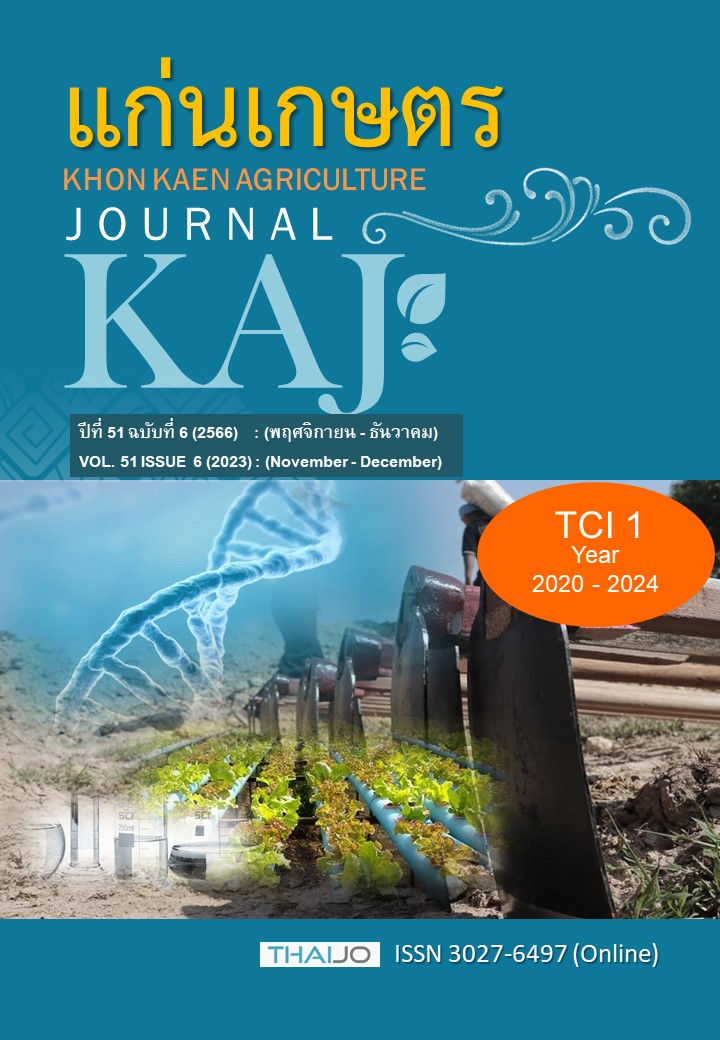อิทธิพลของการปลูกมะเขือเทศแซมข้าวโพดต่อการเจริญเติบโต และผลผลิต
Main Article Content
บทคัดย่อ
ปัจจุบันพื้นที่ทำการเกษตรลดน้อยลง แต่ในขณะที่ความต้องการอาหารเพิ่มมากขึ้น ซึ่งระบบการปลูกพืชแซมจึงเป็นวิธีหนึ่งที่สามารถเพิ่มผลผลิตรวมและค่าประสิทธิภาพการใช้ที่ดินทางการเกษตร ดังนั้นจึงได้ศึกษาอิทธิพลของการปลูกข้าวโพดแซมมะเขือเทศต่อการเจริญเติบโต และผลผลิต ดำเนินการศึกษา ณ แปลงทดลองสาขาพืชศาสตร์ สิ่งทอและการออกแบบ คณะเกษตรศาสตร์และเทคโนโลยี มหาวิทยาลัยเทคโนโลยีราชมงคลอีสาน วิทยาเขตสุรินทร์ ในฤดูแล้ง 2562/2563 เปรียบเทียบ 4 กรรมวิธี คือกรรมวิธีที่ 1 ปลูกข้าวโพดอย่างเดียว ระยะปลูก 80 x 25 เซนติเมตร กรรมวิธีที่ 2 ปลูกมะเขือเทศอย่างเดียว ระยะปลูก 80 x 50 เซนติเมตร กรรมวิธีที่ 3 ปลูกข้าวโพดระยะปลูก 80 x 25 เซนติเมตร และปลูกมะเขือเทศห่างจากแถวข้าวโพด 10 เซนติเมตร โดยปลูกสลับระหว่างต้นข้าวโพด และกรรมวิธีที่ 4 ปลูกข้าวโพดระยะปลูก 80 x 25 เซนติเมตร และปลูกมะเขือเทศในแถวเดียวกันโดยปลูกแทรกระหว่างต้นข้าวโพด วางแผนการทดลองแบบสุ่มสมบูรณ์ในบล็อก (RCBD) จำนวน 4 ซ้ำ ผลการทดลอง พบว่า กรรมวิธีที่ 3 และ 4 ที่มีการใช้ต้นข้าวโพดเป็นค้างให้แก่มะเขือเทศ ต้นข้าวโพดพันธุ์ข้าวเหนียวมีความแข็งแรงทนทานสามารถเป็นค้างให้แก่มะเขือเทศได้จนสิ้นสุดการเก็บเกี่ยว ในส่วนของลักษณะทางการเกษตร องค์ประกอบผลผลิต และผลผลิต การปลูกข้าวโพดร่วมกับมะเขือเทศให้ผลไม่แตกต่างกันทางสถิติกับการปลูกข้าวโพดอย่างเดียว นอกจากนี้ยังพบว่าค่าประสิทธิภาพการใช้ที่ดินของการปลูกพืชแซมในกรรมวิธีที่ 3 และ 4 สูงกว่าการปลูกข้าวโพดอย่างเดียว ผลการทดลองครั้งนี้ ชี้ให้เห็นว่าการปลูกพืชแซมสามารถเพิ่มผลผลิตรวม และเพิ่มรายได้ต่อหน่วยพื้นที่ได้อีกด้วย
Article Details

อนุญาตภายใต้เงื่อนไข Creative Commons Attribution-NonCommercial-NoDerivatives 4.0 International License.
เอกสารอ้างอิง
ชื่นจิตร แก้วกัญญา, อดิศร ยุบลวัฒน์, เอกราช มุกธวัตร, สุนิสา ผลผาฤทธิ์ และอรทัย ยนต์พิมพ์. 2561. อิทธิพลของการปลูกพืชแซมต่อประสิทธิภาพของข้าวโพดและถั่วพุ่มที่ปลูกบนดินลูกรัง. แก่นเกษตร. 46(ฉบับพิเศษ 1): 405-411.
ทองมี เหมาะสม และรัชดา ทนวิทูวัตร. 2561. อิทธิพลของการปลูกพืชร่วมระหว่างข้าวโพดหวานลูกผสมและถั่วเขียวพันธุ์ใหม่ 3 พันธุ์ต่อผลผลิตและค่าการใช้ประโยชน์จากพื้นที่ดิน. วารสารวิทยาศาสตร์เกษตร. 49(2)(พิเศษ): 565-568.
นิภา เลขสุนทรากร. 2540. ผลของการปลูกถั่วลิสง และถั่วปุ๋ยพืชสดแซมข้าวโพดต่อผลผลิตข้าวโพดและสมบัติของดิน.วิทยานิพนธ์ ปริญญาวิทยาศาสตร ดุษฎีบัณฑิต มหาวิทยาลัยเกษตรศาสตร์, กรุงเทพฯ.
สุดสงวน เทียมไธสงค์. 2547. อิทธิพลของระยะปลูกข้าวโพดและจำนวนต้นต่อหลุมถั่วลิสงที่มีผลต่อการเจริญเติบโตและผลผลิตของพืชทั้งสองในระบบการปลูกพืชแซมที่ปลูกหลังข้าวายใต้สภาพน้ำใต้ดินตื้น. วิทยานิพนธ์ ปริญญาวิทยาศาสตร มหาบัณฑิต มหาวิทยาลัยขอนแก่น, ขอนแก่น.
Andrews, D.J., and A.H. Kassam. 1976. The importance of multiple cropping in increasing world food supplies. Multiple Cropping. 27: 1-10.
Aphiphon, P. 1983. Cropping systems. Department of Agronomy Kasetsart University, Bangkok.
Carruthers, K., B. Prithiviraj, Q. Fe, D. Cloutier, R. C. Martin, and D. L. Smith. 2000. Intercropping maize with soybean, lupin and forages: yield component responses. European Journal of Agronomy. 12(2): 103-115.
Degri, M. M., and A. E. Samaila. 2014. Impact of intercropping tomato and maize on the infestation of tomato fruit borer [Helicoverpa armigera (Hubner)]. Journal of Agricultural and Crop Research. 2(8): 160-164.
Etminan, M., B. Takkouche, and F. Caamano-Isorna. 2004. The role of tomato products and lycopene in the prevention of prostate cancer: a meta-analysis of observational studied. Cancer Epidemiology Biomarkers and Prevention. 13(3): 340-345.
Feng, L., W.T. Yang, Q. Zhou, H.Y. Tang, Q.Y. Ma, G.Q. Huang, and S.B. Wang. 2021. Effects of interspecific competition on crop yield and nitrogen utilisation in maize-soybean intercropping system. Plant, Soil and Environment. 67(8): 460–467.
Gebru, H., K. W. Tsadik, and T. Tana. 2015. Evaluation of tomato (Lycopersicon esculentum Mill) and maize (Zea mays L.) intercropping system for profitability of the crops in Wolaita zone, Southern Ethiopia. Journal of Biology, Agriculture and Healthcare. 5(1):132-140.
Hailu, G., K. W. Tsadik, and T. Tamado. 2015. Effect of planting patterns in tomato (Lycopersicon esculentum Mill) and maize (Zea mays L.) intercropping on growth, yield and yield traits of the crops in Wolaita zone, Southern Ethiopia. Journal of Biology, Agriculture and Healthcare. 5(1): 39-49.
Hussain, S. A., N. Ali, A. Rab, and M. Shah. 2008. Yield and economic dynamics of intercropping in summer vegetables. Sarhad Journal of Agriculture. 24(1): 31.
Medina, L. C., and B. A. Pimentel. 2014. Growth and yield of corn as affected by different row inter cropping patterns with indeterminate tomato varieties in Southeastern Ifugao, Philippines, pp. 60-65. In Proceedings of the Regional Symposium on Sustaining Small-Scale Vegetable Production and Marketing Systems for Food and Nutrition Security (SEAVEG2014), 25–27 February 2014. Bangkok, Thailand.
Nakhon, N. L. 1984. Cropping systems. Department of Agronomy Faculty of Agriculture Chiang Mai University, Chiang Mai.
Orasa, D., and S. Narin. 1998. Tomato cultivation. Department of Agricultural Extension, Bangkok.
Upadhyay, K. P., M. D. Sharma, S. M. Shakya, G. Ortiz-Ferrara, T. P. Tiwari, and R. C. Sharma. 2010. Performance and profitability study of baby corn and tomato intercropping. Pakistan Journal of Agricultural Research. 47(3): 183-193.
Willey, R.W. 1979. Intercropping: It's Important and Research Needs. Part. 1: Competition and Yield Advantages. Commonwealth Agricultural Bureaux, Nature.


